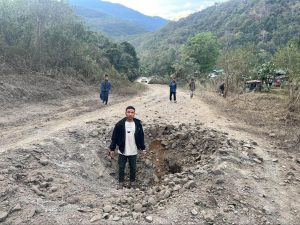On January 10 and 11, the Myanmar regime launched a series of airstrikes against the headquarters of the Chin National Front (CNF), which is located near the India-Myanmar border. Members of the civil disobedience movement (CDM), defected security personnel, and internally displaced persons (IDPs) all reside at the CNF camp.
According to CNF spokesperson Salai Htet Ni, on January 10, four fighter jets carried out four bombardments on CNF Camp Victoria, killing five CNF troops (three male and two female) who were hiding in underground bunkers from a landslide. According to ground reports, two bombs were dropped into Indian territory on January 10; however, New Delhi has yet to respond to the military regime in Myanmar.
According to Mizoram News, the military dropped at least two bombs on the camp at 4 p.m. on January 11, destroying the medical center, which Indian villagers also visit for treatment.
It was the first time that the Myanmar military carried out an airstrike on the headquarters of the CNF, one of the key revolutionary groups that has a formal agreement with the parallel government, the National Unity Government (NUG), to topple the junta that seized power in a February 2021 coup. That said, speculations about the regime’s attack plan have been widespread since the Chin Human Rights Organization (CHRO) revealed a classified plan in November 2022.
The military finally attacked while regime civil servants were collecting eligible voter lists in Chin State in preparation for the general election planned for August, an exercise widely seen as a sham designed to legitimize the military’s continued rule. The incident came only a day after the Chinland Defense Force-Hakha (CDF-Hakha) declared that the coup regime would not be allowed to hold elections in Hakha township, Chin State’s capital.

This photo provided by CNF shows damage to the group’s headquarters following airstrikes by the Myanmar military. The contents of this photo are as provided and could not be independently verified.
The CNF spokesperson suspected that the airstrike assault was part of the regime’s psychological warfare to persuade resistance organizations to abandon their membership in the anti-coup campaign and support the regime’s upcoming election. However, the CNF and public reactions to the incident showed the exact opposite response.
The day following the assaults, Hakha locals went on a silent strike, closing all restaurants and stores. “They strike our camp, but we shall never give in and give up. We shall fight on with growing faith and confidence, and victory will be for us and for the people. So help us, God!” wrote CNF leader and NUG Minister for Federal Union Affairs Lian Sakhong on his social media account. Dr. Sui Khar, CNF vice chairman (III), vowed on social media, “You dared do so, and you will definitely face the consequences.”
Meanwhile, multiple reports claim that Myanmar military fighter jets crossed Indian airspace to strike CNF Camp Victoria. In July 2022, regime jets violated Thai airspace to attack another key revolutionary party, the Karen National Union, and subsequently apologized to Thai authorities for the violation. New Delhi’s lack of public condemnation may have led to the additional airstrike on January 11.
With the Indian government remaining quiet, only the Young Mizo Association publicly condemned military jets flying over Indian territory and dropping bombs on Indian land. A statement from the group said “the bomb had not just hit Indian soil but also partly damaged an Indian vehicle which was near the Tiau river, the International border, to collect sand.”
According to one reliable anonymous source, Naypyidaw had alerted New Delhi of the planned airstrike. Sources said residents in Farkawn, near the Myanmar border, assembled the day before the airstrike to discuss the possibility of a refugee influx into Indian territory in the coming days.
Pro-military media claimed on social media that the air attack on CNF was feasible due to an agreement between the Myanmar and Indian governments. The post also said the regime has agreements with neighboring countries, including the Chinese government, and they could carry out more aerial attacks.
The fact that New Delhi hasn’t condemned the Myanmar military’s reported violation of Indian airspace implies that the junta has the green light to undertake further airstrikes, resulting in more IDPs and refugees along the border.

































